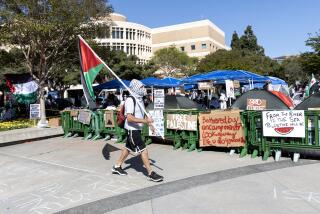Students Stay Home by the Thousands as Rioting Builds : Education: Attendance at some Los Angeles Unified School District campuses in the Valley dips by almost half. There will be no classes today.
- Share via
A day after pandemonium erupted in the streets following the stunning acquittals in the Rodney G. King police beating case, thousands of parents throughout Los Angeles kept their children out of San Fernando Valley schools Thursday, apparently out of fear for their safety.
All Los Angeles Unified School District campuses will be closed today in a city under siege by rioters and looters. But already on Thursday, attendance at some Valley schools was down by nearly half, turning ordinarily noisy campuses into virtual ghost towns.
“This is unusual,” said Leonard F. George, principal of Charles Maclay Junior High School in Pacoima, where 400 pupils remained home out of a student body of 900. “We usually have about 75 absent on a given day.”
“The classes were lonely,” said 18-year-old Edith Papp of Granada Hills, a senior at John F. Kennedy High School, which was also at half-strength Thursday. “Makes you wonder where your friends are.”
Widespread absences were expected following a decision by district officials to curtail busing from violence-wracked South Los Angeles, home to hundreds of students who attend school in the West Valley.
But several campuses reported a surprising number of no-shows by resident youngsters whose parents feared for their children’s safety, or who believed schools to be closed in the trial’s bloody wake.
Field trips were canceled, school “open house” nights postponed and athletic events jettisoned as administrators and teachers struggled to protect their students while continuing the business of education. School psychologists readied themselves to deal with distressed youngsters who wondered about their own security and the plight of classmates from South L.A.
“They’re concerned about their friends. I explained that it was not safe for them to travel through the area,” said Van Gogh Street Principal Maureen Diekmann, who held a campuswide assembly before class began. “They had seen the TV, and they described people stealing things and starting fires. And because they’re so little, they don’t have a sense of where it is, so we talked about how they were safe at school and safe in their homes.”
In the classrooms, predictably, the astonishing outcome and aftermath of the trial hovered on everyone’s lips, from instructors to students, from first grade to 12th, as all attempted to make sense of the chaos that manifested itself in innumerable empty desks.
At Fenton Avenue School in Lake View Terrace, Brenda Peterson tried to explain the volatile situation to her third-graders, who sat in a classroom less than a mile from where white police officers had clubbed and kicked black motorist King a year ago.
“They know what’s going on--they understand the seriousness,” she said of her class, only half of which was present Thursday. “I think they’ve grown up today. . . . They’re not terrified, but they know it’s not fun and games.”
Her 8-year-olds were earnest and eager as she polled their views on the innocent verdicts and the ensuing rampage that unfolded on their television sets.
“They’re both guilty,” said Jennifer Ingram of the exonerated police officers and the rioters. “The cops shouldn’t have beaten him, and the blacks shouldn’t have got that mad.”
“I don’t think it’s just white against black,” said Andy Chicas, offering his interpretation of the violence. “It’s not just the black people breaking everything. There are white people doing that too.”
The overwhelming majority of the class believed that the jury made the wrong decision in the King case, but William Pineda was courageous enough to state his belief in the officers’ innocence, despite his classmates’ giggles. But he too said the rioting and looting were wrong.
“They should stop that right away ‘cause kids in schools are starting fights,” William said.
Down the street at Maclay Junior High School, community leaders exhorted students at an assembly to vent their frustrations in letters to elected officials and in conversations with their parents.
But outside campus, a trio of Maclay students--who were out of school because of a year-round schedule--went public with their opinions, standing at a busy intersection and hoisting signs that encouraged motorists to honk if they disagreed with the verdicts.
“This is the only way we can show we care,” said Ruth Martinez, 13, as she waved vigorously at a sympathetic driver.
“And also so that black people won’t say we’re against them. We’re with them,” added her friend, Araceli Gallegos, 15.
“It doesn’t matter how old we are,” she said. “At first, we were afraid to do this--what if we get arrested? But if we get arrested we don’t care. It’s the right thing to do.”
But to 16-year-old Pablo Perez, a San Fernando youth who attends Kennedy High, the issue of right and wrong was overshadowed by the escalating crisis on the streets and a strong sense of despair, especially on behalf of immigrant relatives.
“It’s sad for me to see my grandparents see this,” he lamented. “They just came from Mexico and think the United States is beautiful.”
Higher education in the Valley was also affected by the city’s state of emergency.
Pierce College closed its campus at 4 p.m. Thursday in light of the citywide dusk-to-dawn curfew and may be closed today. Mission College will remain closed until Monday, and Cal State Northridge has canceled today’s classes. out of concern for students’ safety, CSUN spokeswoman Kaine Thompson said.
Also contributing to this article were Times staff writers Jim Herron Zamora and Aaron Curtiss.
More to Read
Sign up for Essential California
The most important California stories and recommendations in your inbox every morning.
You may occasionally receive promotional content from the Los Angeles Times.














